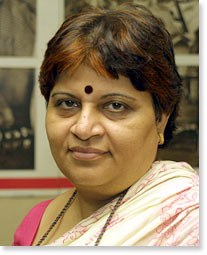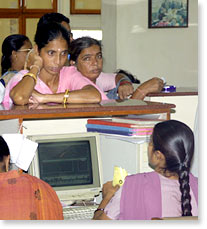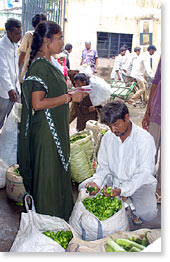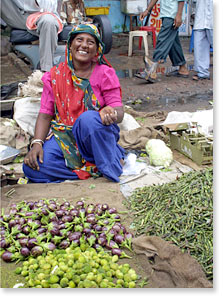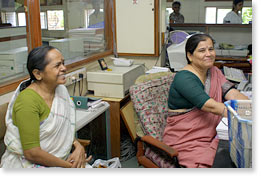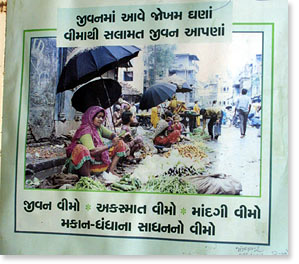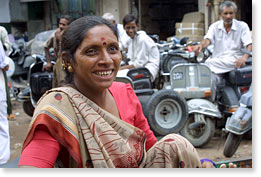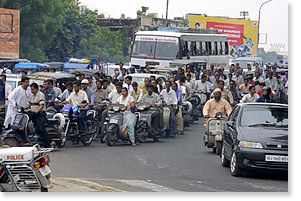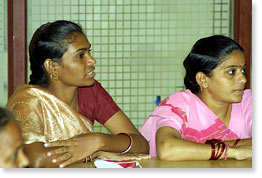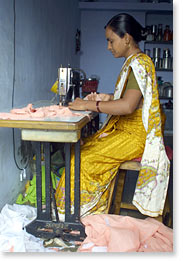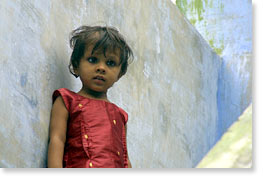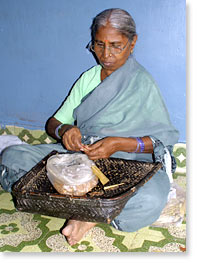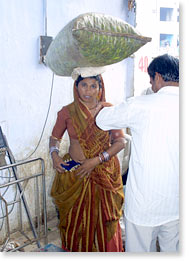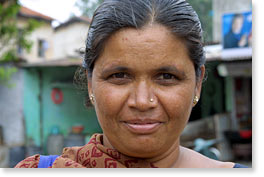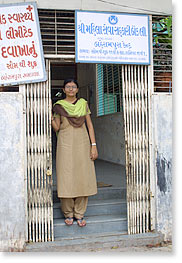|
Interview with Jayshree Vyas
Managing Director of SEWA Bank To Come Out Of This Vicious Cycle Of Poverty Ahmedabad, Gujarat, India
In Motion Magazine: How did the bank come into being? Jayshree Vyas: Ahmedabad City is the place where Mahatma Gandhi started his movement of independence. He had started a trade union of the workers of the textile industry because Ahmedabad is a textile center. This trade union had a small women’s wing. That wing was headed by Mrs. Ela Bhatt (editor: Ela Bhatt, founder and first general secretary of SEWA) and this women’s wing was working with other women workers like ready-made garment makers, vegetable vendors, and home-based workers like the women who are rolling bidis, rag pickers, waste paper pickers. When a survey was made on those women it was found that those women are working very hard. They are working for 18 hours a days earning very little, like a dollar a day or two dollars a day. They are living in very bad conditions. They are living in slums. They don’t have any social security. They earn if they work and they don’t earn if they don’t work. They are working very hard and are economically active but they are exploited by moneylenders. They don’t have their own capital. The main reason why they are poor is they are not organized. They are not visible as workers. They are not recognized as workers. Self-Employed Women’s Association So, it was decided to organize these women. That is how this whole organization of SEWA, that is Self Employed Women’s Association, came into the picture, came into existence as a trade union as a union or the organization of women workers in the informal sector – that is the small vegetable vendors, the home-based workers, the construction workers, headloaders, laborers, those women who are very economically active.
Now, when they started organizing there were two major problems, coming in. Side one was the lack of capital. For example, a vegetable vendor would borrow rupees-hundred in the morning, would buy vegetables and trade in vegetables and at the end of the day would repay 110 rupees. If you calculate the interest rate it is more than 3,000 percent. So, one problem was lack of capital and borrowing from moneylenders at very high interest rates. And a second problem was that they didn’t have their own assets. For example, a ready-made garment maker would not have her own sewing machine. She would have to make it in pieces. As aresult, income was very low and a very big portion of that income was going either towards interest or towards rent. Providing credit So, we realized that they need credit. They need credit at a very low rate of interest. Maybe providing credit would be good for them. Then, luckily, at that time in our country the banks were nationalized. All the banks became government banks and they were very eager to serve the poor. So we organized. We managed to take those women to the banks and we thought that the problem was solved, that OK, now women are going to get the credit. But actually the problem was not solved. It was the beginning of the problem because those bankers, the formal bankers, they had never seen those women. They had never dealt with those women. Women were going in filthy clothes with children in their hands. They were not even able to keep a time schedule. They would finish their household work, they would finish their business, and would go to the bank and the bankers would say, “Now the bank is closed.” She might have borrowed from one bank and forgotten from which bank she had borrowed and she would try to go and deposit money in some other bank. Sometimes, even the name which she would give would (be different) because she is not identified as an individual. She would give whatever is her mother’s name, or whatever name she thinks about. And the bankers would not find it proper. They want the proper perfect name. So, they were not able to give their names. They were getting 500 rupees in lump sum and many of them they were seeing 500 rupees in a lump sum for the first time in their life. They were afraid that if they took this money home it would be spent somewhere. So we also realized that it is not only that they need credit but they also need some safe place to put their money. There were all these practical difficulties they were facing. A major thing which they were feeling was that, “We are not accepted in these formal banks.” They were so reluctant to go there because they were insulted often. The mechanisms which were used by the bank were not useful to them. They were illiterate. They needed some assistance in filling out the forms. Filling out the withdrawals and other forms. There was no assistance coming to them. It was extra work for the bankers. So, when they were facing all those practical difficulties, we had a meeting in early ’73 of all these women, and these women started coming on the stage and talking about the practical difficulties they have. And one of the members, we have her photograph here, one of the members suggested, “Let’s start our own bank”.
Initially, nobody took it seriously. How can there be a bank of poor illiterate women. But what she was saying was that, “Yes, we are poor but we are so many.” What basically they were saying and she was supporting many of the leaders there, was that, “We want a place where we are accepted as we are. Where we are not insulted. We are accepted as we are.” And so, if at all we wanted to start a bank then we needed money. We needed capital. We asked, “How can we collect this money, capital?” and all those leaders who were present there they took the responsibility of collecting the capital required. Ten rupees each. Within a period of six months they collected from 4,000 women the required capital. And then we went for registration, registering as a bank. Again, the first question that was asked, was, “A woman who does not know how to sign her name, how would she be able to operate her account?” And our answer was that our impression was that, “Yes, it is true that they don’t know how to sign their names but they are all economically active and they do need banking services. In a country like India where many of the people are illiterate, does that mean that the whole banking sector will bypass its own population just because of the reason that they don’t know how to sign their names? No.” Ultimately, why a signature is required it is required for identifying a person. So you can always find some other method of identifying a person. You can take a thumb impression. You can take a photograph. And that’s what we suggested. We are still known as the bank of people who give their thumb impressions, who are illiterate. Learn how to sign their names So the thing which they were asking of the promoters, of the fifteen initial promoters who were required to sign -- these women who were vegetable vendors, or a garment worker, or a rag picker – they also didn’t know how to sign their name. The registrar said, “At least these fifteen women should know how to sign their names.” So what Elaben did was she locked all these fifteen women in one room and told them, “You learn how to write, how to sign and then only I’ll open this door.” And all these women sat throughout the night and learned how to sign their names. So, that much was the enthusiasm that they wanted a bank of their own. So, we got a registration in ’74 but even at the time of giving the registration, the person who was in charge, he told Elaben, “Look, as a real brother I am giving you advice that this is a suicidal attempt you are making. These women are coming from this caste and this community and they’ll run away with money and a time will come when you will have to commit suicide.” That much was the resistance. “How can there be a bank of these women?” “Are they capable of it?” Basically the question was, “Is it possible to do a viable banking business with these women?” The only thing that we had was trust in these women and the commitment that, “OK, we want to provide these services to them.” Otherwise, we didn’t have any experience as bankers. We didn’t have any blueprint to follow how banking can be done with these women. The only thing which we had was a commitment and trust that these women will be bankable. And we can trust that. So, Elaben is still alive, so she didn’t commit suicide. We have at present more than 200,000 women who have been regularly saving with us. Our main objective is to have these women come out of this whole vicious cycle of poverty. This is basically bringing them out of the clutches of moneylenders because they have to pay very high interest rates to them. The first step for helping them form capital is to give them a loan to repay the moneylender so at least they save on the interest. Like if she has borrowed 5,000 from a moneylender, she is paying ten rupees, ten percent per hundred rupees every month. That way she is paying 500 rupees as interest only. So if she is repaying this, taking a loan from us and repaying this, this way she is saving 500 rupees. Our interest is less. It is one rupee per month – which is 12 percent. She is saving almost 425 rupees every month, for example. So the first step is to help them to come out of the clutches of the moneylenders. The second step is to slowly, slowly help them to build savings. If you want to, tomorrow you can go and see there are women who have been saving on a daily basis. Five rupees per day, ten rupees per day, we are collecting all this money from them on a daily basis. They say savings is not only one requirement but it is also giving hope because saving is something which you look forward to. Something planning for the future. Something thinking about the future. There are lots of savings products.
Expansion of business The third step of capital formation is that they take a loan for expanding business. Small loans, like if she is buying 1,000 rupees of vegetables she will borrow two thousand more and she can buy vegetables of 3,000 rupees. Her working capital goes up and because her working capital goes up her profit also goes up. So her income goes up. So, expansion of business. If she is in the food processing business and if she is working for someone else, she wants to work on her own. She wants to buy some machines. Some working capital is required for her doing her business. Then she takes the loan for this purpose and then she expands her business. Instead of working for others she has her own business. She employs more people. That’s taking a loan for business. Taking a loan for buying equipment. In many of the cases, lots of work is done manually. For example, we have lots of women who are carpenters and for them when they are doing work manually it is so laborious. If they have to make a hole in the tin for making some utensils they have to hammer 25 times so that they can make one hole in the tin. When she buys a machine, it doesn’t matter even if it is even second hand, but when she buys a machine she can make the hole very quickly and without any manual labor. It increases her productivity. It decreases her drudgery. Lots of loans are given for buying equipment, like sewing machines. I don’t know whether you have seen the machines, but some machines are operated by feet, manually, and some machines are operated by the motor. They can convert that into a new machine with a motor. And the last stage of capital formation we have seen is they want to improve their living conditions. They are living in a mud house, so they want to have a cement wall. Or they want to have a non-leaking roof. Or they want to have water connection. A lot of them don’t have water connections in the homes. They want to take water connection in the home or they want to take electricity. If she wants to buy a machine she needs to have electricity in the home first. So the first thing we would say she would do is get electric connections and then buy a machine. Basically improving the living conditions. In the majority of cases, our members are home-based workers so for them their home is their workplace. They are working there. It’s a processing house. It’s a marketing outlet for them. It’s also a storage place for storing raw material and for storing finished goods. It’s also the place where they are staying. And these are small houses. So, when they have a little improvement in the house that helps them to increase their productivity again. Some women who are in the food processing business, when they have a mud floor and all the moisture comes down whatever they are producing becomes soggy. When they have a tile floor then the moisture stops coming down and whatever food product they are making is of better quality. Or, when they have a water connection in the home they don’t have to spend two hours, three hours standing in the queues for fetching water. In the slums the majority of fights take place at the queues for fetching water. So that saves them from lots of drudgery. Helps them to save time, to save money which is helping them to increase income, basically. This is normally the capital formation process our women are going through: the coming out of the clutches of moneylenders; building the businesses; building the savings; having more assets and equipment; and having better living conditions.
But often we have found that the process is going up but suddenly there is a fall in the whole process because, for example, she is sick. And for her, her body is her asset. She is a manual worker and if she doesn’t work for that period there is no income. They don’t have sick leave. They are not formal workers. In that case they don’t earn money during that time as well as they have to spend on medicines. They have to withdraw money or they have to again go to the moneylender. So, one is the sickness, the second is during maternity, during delivery. Or (third) when there are natural calamities like floods and cyclones or man-made calamities like the riots we had just now. Whenever there are these calamities it is these people who are affected the most because they are living at the river side or they are living in slums. They are affected and their total economic life is disturbed. Whatever they have built is destroyed. In that case, what we have tried to do is to provide them with insurance for sickness, insurance for accidents, insurance for loss of assets during riots and floods and cyclone. It is a combination of three services basically – savings, credit, and insurance. Their lives have improved In Motion Magazine: So the ones who first joined back in the ’70s, how are they doing now? You can see that their lives have improved? Jayshree Vyas: We would say not all but many of them. For some examples, vegetable vendors who were sitting in the street and selling vegetables -- now many of them have shops in the market. Or food processors who were doing only a small volume of business, they are now in the wholesale business. Or those women who had mud houses, now they have a full-fledged cement house with all the facilities in the home. There is improvement in the living conditions, improvement in the business income, assets. Among informal workers the majority are women In Motion Magazine: Why did you focus on women? Jayshree Vyas: One, we found that in India, particularly if you really see the work force, the majority of the work force is in the informal sector. The formal sector workers in our country are only 10 percent (of the total). Formal is like somebody working in a bank, like me. Or somebody who is working in an insurance company, in factories. Who have regular employment. Who are earning monthly income, a regular monthly income. Who have privileges -- they get regular leave, and other benefits. They have a formal employer/employee relationship. But 90 percent of the workers in our country are in the informal sector, and it is increasing. They are the maids working in the home. Or they are agricultural workers. Or they are construction workers. Or they are vegetable vendors. Among these informal workers the majority are women. These women who are working in the informal sector they are the people who are very poor. Having a background of a trade union, we realized that if we really want to work with a purpose, if we, at all, are really wanting to work with the workers, this is the category of workers which is the most vulnerable. Vulnerable, one, because of the type of work activities they are involved in. Two, because of the social status of these women. And third, because of the biological reason. Why not work with the weakest and the most vulnerable group? For this vulnerable group, as an individual, for a woman working individually, to come out of poverty is almost impossible. The first thing which is required to be done is to bring them together. To organize them. This is the approach that SEWA has been taking -- that the first and foremost thing is to organize these women together. Organizing could be through a union. It could be through cooperatives. It could be through the bank. It could be through anything. But organizing women. And once the women are organized they need all the services. They need banking services. They need legal aid. They need healthcare. They need childcare. They need training. When all those inputs are coming in together then she has been able to come out of poverty. That is basically the approach.
In Motion Magazine: How do you keep in touch with 200,000 people? Jayshree Vyas: First, a majority of our work is done in the field. What we have been doing is selecting women from our own members to be the field workers and go into the field organizing meetings with the women, organizing training with the women so there is a continuous contact with the women.The second thing which we have been doing is we have selected some of the women from among our members, from these 400,000 women, and they are given the work of collecting money from women, insuring that the money comes back from providing the loans, getting (the payments). So, it’s lots of leaders from the areas who are working for us that help us in building up a continuous contact, a continuous relationship with these women. For example, we have the daily saving scheme. In this daily saving scheme what we do if there is a group of a hundred women, a hundred vegetable vendors, and they are selling vegetables in one of the areas, we have selected two women from those hundred women who we call “bank satis”, that is bank friends, and these women are trained about the different schemes of the bank. They are trained to collect savings and keep the accounts of the savings so they collect that money from these women and bring it to the bank. We have 200 such areas which are covered on a daily basis by these bank satis, our bank friends. They are leaders. We have a number of meetings. We have a number of regular meetings. We have big meetings where women come together. They share their experiences. We are constantly trying to keep in touch. They are the owners of the bank In Motion Magazine: Are there matters that they vote on? Jayshree Vyas: Oh yes. Because this is a cooperative bank it’s member based, so when a woman buys shares she becomes a member of the bank and she gets the right of voting. Voting, one, is about electing the leaders, electing the board members. They have a right to vote and elect board members. And these board members -- there are fifteen board members -- they are the people who are making all the policies for the bank. It’s basically the board of directors. They elect the board members, the board of directors, who are making the policies for the bank. That’s one. Second, is that every year we have an annual meeting where all the books of accounts are put to them and they have to approve the books of account. They review the performance. They review the policies of the bank. They have a legal right to vote. They are the members. And they have the right to share the dividend. If we earn a profit we give them a dividend. Basically they are the owners of the bank. Healthcare, childcare, cooperatives, more In Motion Magazine: Is the bank the heart and soul of SEWA or is it one aspect of SEWA? Jayshree Vyas: It is one of the major activities of SEWA because it is the first cooperative which was started by SEWA union. But there are also other activities that SEWA is involved in. As I said, there is the healthcare trainings given to these women. There are medicines, shops where low cost medicines are sold. There are childcare centers because we often found that women are not able to go and work because they have to take care of the children. Many times we saw that the elder sisters had to leave school because they had to take care of the younger brothers. There is a need for childcare centers so that the women can put the children there where they get some education as well as nutritious food. We have lots of childcare centers. We have legal aid. And I talked about the insurance. We have the housing unit which is helping look at the policies of the government. Providing them with technical support for housing if they want to build a house. There are income-generating activities where women are coming together to form cooperatives of their work. There are marketing facilities. Leadership training. Vocational training. Different types of training. We have a communication unit which is video. We also have a fortnightly magazine.In Motion Magazine: Do you take political positions, as a large organization? Jayshree Vyas: All our actions are political actions because we want to change the policies but if you are asking about party politics we are not into the party politics. We are not elected MPs. We are a non-political body. In Motion Magazine: But you say everything you do is political? Can you explain that? How do you see changing society through what you do? Jayshree Vyas: One major thing which we have been doing is building up the leaders. Building up women. Say, for example, a vegetable vendor, she has grown (up) as a vegetable vendor. She has seen her mother also as a vegetable vendor. For her, her world is her mother, her family, and her business to a certain extent. But having information and knowledge about the outside world, about what is her role in the entire economy, for example, -- she is playing a major role in the distribution system. Our trainings do show her the larger picture.
The political position that we have taken is to organize all these vendors. Make them understand. Make them know that they are contributing in the economy and they have a right to sit there. To take them to the local authorities and tell them, “Look, local authorities, either allow them to sit here or you give them some alternative place.” And if the local authorities don’t agree, then the next political action is that we go to the court. And we went to the court. We went to the Supreme Court and fought for these women, the right to work, basically. They have been sitting there since last many generations and if at all a country or a city is planned these vendors are an integral part of the whole city so why not plan for vending zones, selling zones. Taking this up to the policy level, taking up an individuals case up to the policy level, this is a political (act). Building up democratic organizations In Motion Magazine: Do you think there is a connection between building a democratic society and being involved in the economy in the way that you are talking about? Jayshree Vyas: Yes. That is one thing. The other thing is, for example in the rural areas what we have been doing is that we have been organizing women’s groups, savings and credit groups. Women are coming together forming an organization of their own. We have 3,500 such groups and in these groups what is done is done very democratically. They come together. They decide how much they’ll save. Where they’ll put the savings. They’ll maintain the books of accounts. They will decide who will get the loans. What interest rate is to be charged. There is a reason that they have a saving service. They are getting the loans so this is a service, but the process, the entire process is that you are building up an organization at a very village level which learns how to run an organization, democratically. You meet together. You meet regularly. You discuss the issues. You decide unanimously or you vote for it. And you have a right to vote. This is how the organization works. It is basically building up the democratic organizations at the grassroot level. It has really helped that our (Indian) constitution was changed and a momentum was brought into every village that there will be Panchayat, the local authorities, the elected local authorities, and one third of those elected body members should be women. Now this constitution has come, the law has come, but you need people to be there to take their part. You need women to be very active. So what automatically happened was that all those leaders that were leaders of the savings and credit groups they started getting elected in those local bodies. And then we have seen often they have become the presidents of those local bodies, the village bodies, the village Panchayats. And the decisions which those women are taking -- for them priority is water, for them priority is schools for the children -- the entire (set of) priorities for all those local authorities, where the money has to expand, is also changing because the women are taking part in it. So small action does lead to (change).
In Motion Magazine: Do you see people change as they become involved? Jayshree Vyas: Yes. We have a custom of if you wear a sari you cover your face and many women have covered their face. Well, the first thing which happens when we tell them to introduce themselves (at the first training) they take it off because they have to introduce themselves. They have to give their names. In the first training, they are so reluctant so shy to say their name but if you see them they are talking about their issues, their problems. So, when we ask these women, “When do you feel you are empowered?” They often say that, “If we can say our name in the presence of 50 people we feel we are empowered.” “If I can come out of my home and I can go to the city, to Ahmedabad, or to Delhi, that’s empowerment for me.” “If I can go to the government office and talk about my issues to the government officer, to me that is empowerment.” Different people have different perceptions about their empowerment. They do say this is an empowering process. In Motion Magazine: In the training I was just in, I noticed that at least three quarters of the women were quite young. Is that generally true among the organization, or is that just because they are new? Jayshree Vyas: No. I am a little surprised that in this kind of training we see lots of younger girls. Normally our profile is the majority of our members are from 55 to 45 age group because they are the most economically active at that time. In Motion Magazine: Do you think it is changing that now you are getting the daughters? Jayshree Vyas: I think that this is the second generation and also, this is very interesting -- I talked about the services like saving, credit, insurance, and talking about life-cycle needs -- they need money for different purposes and we should be able to meet all those needs. Money is fungible. Many times we have seen that she has borrowed for working capital for the business, and she goes home and her child is sick so she is spending all the money for the sickness. Often they are borrowing for one purpose and then using it for the marriage. There is a need for understanding the whole finances because these women they are used to living on a day-to-day basis from crisis to crisis. They are illiterates. They haven’t gone to schools about planning. They haven’t seen their mother and father doing planning. For them, thinking about tomorrow, planning for the future, is something very new. We must have this kind of service, financial counseling. We call it financial counseling that women come together, that they understand the importance of planning, that they understand what is interest and how interest is calculated. And how it is useful to borrow from SEWA Bank rather than borrowing from moneylenders. Those basic financial concepts, they need to understand those concepts. And the major thing is planning for the old days because when we did one survey of 400 women that, “Are you planning for your old age?”, and there was zero percent. All of them said, “We even don’t know what is going to happen tomorrow. How about thinking about planning for old age?” And this is the reason why. The first generation of our members, many of them are 65 or 70 but they still have to work. They don’t have any food unless they work. They earn on a daily basis. We don’t want that to happen to our next generation. This is a very recent service which we have started -- financial counseling. And maybe that is the reason that the second-generation people are keeping, in the first. But we do want the first generation also to come.
We were basically thrown out In Motion Magazine: What are some particular milestones in the development of the bank as it changed over the years? Jayshree Vyas: As I told you, we were a part of the Textile Laborers Association (TLA) and up to ’80 we were together. We were with them but there were some conflicts between the TLA and SEWA. SEWA was formed by TLA but TLA was lead by men and we were basically thrown out of that organization. At that time, it was a real crisis because not only were they throwing us out, but physically we didn’t have a building. All our deposits were withdrawn and we were really in crisis. At that time, we had to be on our own but thanks to our organizers, they said, “Don’t worry about it. If we don’t have a building, we will sit under the tree and run the bank.” They physically did it in the sense that they went from street to street and collected deposits because we needed capital. They announced lots of new schemes and then went from one place to another place and collected all the savings and got running again. The major difference we saw was that when it was under the control, even when the chairperson was a man … . -- I have nothing against men. – Our performance up to ’81, the growth rate was very slow. We were growing but we were not growing. Our loans were also not growing. It was very much conservative. But after ’81 we really started growing. We really started working as a bank. That was one of the first milestones. During India’s declared Emergency But maybe the first one was even earlier than this. Another crisis was that in the country we had a political situation where there was an Emergency declared. This was Indira Gandhi. She declared -- and this was earlier than ’81 -- a waiver of loans for the poor because there were all these anti-poverty programs going at that time. She declared that all the poor who have borrowed, basically from the government banks, will not have to repay. It was a political announcement but our moneylenders, our competitors, they took this approach in India and they told to all our loanees, “This is declared and now you don’t have to repay the loans.” So we were really in crisis. We went from house to house to tell them that, “This (SEWA Bank) is not a government bank. This is your own money. It is coming out of your own savings and you have to pay back this money.” In Motion Magazine:How were you received? Jayshree Vyas: It did work. It did work explaining to women how SEWA is different from the government banks and if you are not paying the money back you are hurting other poor women because the money is coming from poor women. It is the whole question of cold money versus warm money. They always considered government money as cold money. This is the money which it is OK if you don’t repay. But if the money is coming from their own, if it is their own money, then it has to be repaid. It did work, but luckily at that time we didn’t have many loans. Business partners In Motion Magazine: What are the men doing in all these families? Jayshree Vyas: In many of the cases, more than 50% of our members’ cases, these are family businesses. The husband is also a vegetable vendor and she is also a vegetable vendor. Or they are doing a carpentering business together. But in other cases, they don’t have regular employment. Either they are working in factories but they are contract laborers, or they are working as laborers somewhere else. Some of then are unemployed, not doing anything. That is also a major problem -- that they are not doing anything. Drinking. Responding to earthquakes and riots In Motion Magazine: Did you as an organization develop a special response to the (1998) earthquake or the (March 2002) riots? Jayshree Vyas: In the earthquake, a majority of the rural members were effected. Our urban members were also effected but their houses were not destroyed because the houses were so thick. (In the city) it was the big buildings which were destroyed. Physically, we were effected. We had cracks here. We had to run the bank outside on the road, under the trees, for three months. In Motion Magazine: For three months you were under the trees? Jayshree Vyas: There were lots of aftershocks. But in the rural areas the houses were destroyed and they didn’t have the income. Income generating assets were destroyed. There were three parts to our response. One was the immediate help. The immediate help was that they needed food to eat. So we were working with some food packets. That was very urgent. But whenever we went and started giving them some food packets and other things, what they were saying was, “OK. This is OK. We thank you for this, but what we really want is work. Give us work. Have you brought some work for us?” So, then what we tried to do was to link them with either organizations or individual traders. For example, in some of the areas they are embroidery workers and we tried to link them with the traders. We tried to ensure that they were getting the embroidery work. Or, in some of the areas where they are ready-made garment workers, we even bought some machines and gave them some work. Basically giving them some income-generating activities. That was the second one. And the third one, and it was little bit of the longer term, was helping them to reconstruct houses. We have reconstructed around 2,000 houses. Helped them to reconstruct the houses. Involving them in designing.
Jayshree Vyas: Their own houses. Each other’s houses. In Motion Magazine: How did you help? Jayshree Vyas:Women in the housing unit of SEWA, they appointed engineers and the first thing which was required to be done was to design the houses. The engineers had them design the houses. They sat together and designed the new houses, which had to be earthquake proof. The second one was the money part. We did get some funds from outside for buying the material -- everything been had destroyed, so they didn’t have money for material – and the financial help came through us. The third one was the actual construction. They were digging the foundation but then all this other work which was required to be done was either done through hired labor or through engineers. We had them basically building their houses financially as well as physically. In Motion Magazine: How about the riots? Jayshree Vyas: The riots were a little bit more tricky because they were man-made. And we are working with both religions. One third of our members are Muslims. We had to work with both the communities. Many of them (the members) were affected. Their houses were destroyed. Their income generation was stopped because (the area) was under curfew for two months. Those families who had lost their houses they were shifted to the refugee camps. In that case, what we did was we started working with the refugee camps because many of our members were also there. The first thing which was required to be done was again the food packets. We started working with the food packets. The second one was working with children because children were really in trauma. They had seen everything happening and they were thinking and thinking about the same things again and again. We thought that the first thing we should do is set up some kind of childcare centers in those camps. We started working in the childcare centers. The children were coming. Even the mothers were coming. They were drawing some things. They were painting some things. Storytelling was going on. The children were involved in lots of activities. The third one was the healthcare requirement because in the camps there were thousands and thousand of people and there were no hygienic conditions. They were falling sick. Healthcare was also built. Then the work, they also wanted some work. They also needed to be active otherwise they will think about the same thing and then they will be … . They were given sewing machines, some laundry work, and other work. But also lining them up with traders, bringing those traders’ orders there. When they worked we would take the finished work to the traders. We helped them in generating, building up the income. Generating activity again. And the last thing which we did was the healing process. This is what we have seen -- women are a good source of sending the messages. Here we met with both the communities’ women together. We started organizing meetings and we organized centers in those areas which had Hindu as well Moslem communities. Like if the Hindu community was here and the Moslem community here, we established our center in the middle. Women started talking and now the latest thing which we have done is that now they are celebrating festivals of both the religions together. In Motion Magazine: How many people were affected by the earthquake? Jayshree Vyas: If you are talking about the economic activity, the majority of families were affected. In Motion Magazine: Of the people in general, not just your members? Jayshree Vyas:We are talking about the members because what we have seen is that whenever there is this kind of crisis it is the poor people who are effected more. Work was not available. But the destruction of houses -- 60,000 houses of our members were destroyed. 60,000. Reconstruction work is still going on. 60,000 houses were destroyed. And loss of assets -- it ran into millions. In Motion Magazine: How about the riots? Jayshree Vyas: This time the riots even went into the rural areas. Around 20,000 families in Ahmedabad city and around 400,000 in villages. In Motion Magazine: How many people live in Ahmedabad? Jayshree Vyas: Four million. In Motion Magazine: And 90 percent of those are in an informal economy? Jayshree Vyas: Yes. Agarbatti In Motion Magazine: What is agarbatti? Jayshree Vyas: Incense sticks. There is a stick and then there is some dough with the incense. What they have to do is put all the small sticks together and then they roll the dough on it. When they are making thousands of such incense sticks they will get five rupees. There are lots and lots of women who are doing this for the whole day. If they do it for the whole day they will get one dollar or one and a half dollars per day. We have those women as members. Home-based workers, basically.
In Motion Magazine: Can you go over the different types of workers who are members? Jayshree Vyas: One is the vegetable vendors. Vegetable and food vendors. Egg vendors, and fish vendors, and those who are having small shops, and those who are selling milk. But, basically, vending – selling. The second category is the home-based workers. That is those women who are sitting home and working. They are the bidi rollers – the bidi is a kind of cigarette. What they do is they get from the contractor the tobacco, the leaves, the thread, and they sit for the whole day at home and make those bidis. Roll those bidis. For making one thousands bidis they were getting five rupees. Because they are organized and they have fought a lot, now they are getting thirty-four rupees for making one thousand bidis. Actually, amongst our members the organizing has helped the most those bidi rollers. They are quite well organized and they have got quite a lot out of the organizing. They also get lots of benefits. They are getting some healthcare centers from the government. Others are ready-made garment workers -- like those who are sewing blouses, and frocks, and those kinds of things at home. Then, there are cane workers -- cane and bamboo workers who are making baskets and other things. There are embroidery workers. There are patch workers. There are block printers who are painting by blocks on cloths. Head-loaders, handcart pullers … The third category is laborers. Head-loaders who are taking all the loads on their heads from one place to another place. There are handcart pullers. There are rag pickers. There are construction workers. Then, in the villages there are agricultural workers. There are salt workers – making salt. There are carpenters. In Motion Magazine:Do rural workers come into the city to see you? Jayshree Vyas: We have offices in the rural areas. District offices. And there we have the organizers. We have the field workers, the leaders, the whole structure. In Motion Magazine: Is it bad for the body to carry that load on your head? Jayshree Vyas: It is. Sometimes they lose all their hair. In Motion Magazine: Do you encourage them not to do it or is that just what they do? Jayshree Vyas: One is that instead of head loading if they have a handcart then they carry it in the cart which is less laborious as compared to the head loading. We give a loan for that. But the handcart they are using, usually it doesn’t have a brake so when it is carrying a lot and there is a slope they often meet with an accident. So, what we did was we went along to the students of national industrial design and they designed a cart which had a brake. So, basically, we help them with a technological advancement, looking at the way that they are doing it and then trying to help them to reduce the drudgery and ensure that it is safer. A dual strategy of struggle through union and development through cooperatives In Motion Magazine: I read a SEWA article about your approach to organizing in a situation where there is a seeming unlimited supply of labor. Could you talk about that?
If a woman was taking help of her daughter and worked for eighteen hours she would be able to make two quilts in a day and she was getting 50 pesas, half a rupee for making one quilt. The trader, in turn, would sell it at eight rupees -- so for 16 times more than what he would pay for them. And the trade union, because these women were members of the trade union, took up this matter with the traders and said, “You have to increase this amount. 50 pesas is too little.” And to our surprise the traders agreed to it and said, “OK, instead of 50 pesas we will pay her one rupee and 50 pesas. Three times more.” But, in turn, what they did was they stopped giving work to those women who were very active in this whole process. For some time, the other women shared their work with these women but for how long it can continue? They basically became jobless. We were trying to help them to increase their income but eventually they become jobless. It became a model responsibility of SEWA to help these women. So, when we came together and were trying to find a solution, the solution which came to our mind was that the women already have the skill to make it (the quilt), so instead of making them for other traders, if they buy the scraps from textile mills directly and make them and sell them directly, then that would be helpful. They decided to form a cooperative and they have a cooperative which has a shop just besides the traders for whom they were working. That was the first income-generating cooperative and it is exactly as you were saying this changed our whole strategy. We realized that in a country like India, where the supply of labor is more than demand for labor, only struggle, struggle, and struggle through union cannot help. You need to have an alternative. From that we have a dual strategy of struggle through union and development through cooperatives. We now have around 85 cooperatives. Around 20,000 people. There are different types. We have the artisan cooperatives with the cane and bamboo workers’ cooperatives. There are block printers’ cooperatives and patch workers’ cooperatives. The second type of cooperatives is vendors’ cooperatives like vegetable vendors’ cooperatives or fish vendors’ cooperatives. Instead of selling vegetables individually they get contracts for selling vegetables in the jail or the hospitals, so bulk orders. In the rural areas, there are mill cooperatives, the land-based cooperatives. Then we have service cooperatives. Those women who are cleaning houses from house to house now they have formed a cooperative and they are taking orders for cleaning offices, whatever. Then we have rag pickers cooperatives. Instead of going from street to street they are getting all the waste paper from the government. So, it’s again the bulk. Rag pickers In Motion Magazine: What does a rag picker do? Jayshree Vyas: They are waste paper pickers. They are those women who have been going from street to street early in the morning to collect all the waste, whether it is plastic or paper. Collect it and carry almost 20 kg, or whatever, on their back walking 16 to 18 kilometers a day. And come in the afternoon by home and sell it to the trader and get around a dollar. In Motion Magazine: What would the trader do with it? Jayshree Vyas:They recycle it. They sort it out. The plastic waste goes at a certain rate and the paper waste also.
In Motion Magazine: Where do you see things going? How much change do you foresee? Jayshree Vyas: One major thing is that often what we find is that there is pessimism around the poor people. “Nothing is going to happen.” A mental condition or position that, “We can’t do anything.” “Nothing is going to change.” “Nothing is going to happen.” And it is the whole process of building up, organizing, which plays a role of giving a hope that we can change. Something can change. We can do something. That we have seen. It’s changing the whole atmosphere so that, “OK, we don’t have to fear.” It’s the hope that we can do something that we have seen happening. There is lots of curiosity amongst the illiterate that, “We need to know.” “We want to know.” They always are feeling that, “We didn’t go to the quality school so we didn’t get the information,” so whenever there are efforts made to give them some information, to give them some skill upgradation, they are very eager. When we have trainings we call ten people and twenty turn up. There’s lots of curiosity. It is basically helping us to change the atmosphere and is bringing up the hope. And then the government does listen to us. Actually, it is the pressure which works and we do see that from invisibility these women have come to the visibility of the policy makers. Like for example, recently the government announced a pension plan, pension reforms, and in that a major role is given to the informal sector workers. This we never used to have in the government policies. Now when government policies are announced on housing they do talk about slums. Now it’s at least coming into a level of policy change, recognition. In Motion Magazine: You mentioned at the beginning of this interview that Ahmedabad was a center of Gandhi’s movement. Is there a tie-in there in the way that you work? Jayshree Vyas: Yes. Gandhiji was always saying that if, at all, reform is going to come it is going to come from women. He always had hope for the women. We are also keeping women in the center. We have the simplicity and the messages which values he has put in the whole country. We have been following lots of values but we trust in women’s power and we feel that it is the rural area and it is the poor, the rural people, who are going to change the country. Published in In Motion Magazine January 1, 2004 Also see:
|
||||||||||||||||||||||||||||||||||||||||||||||||||||||||||||||||||||||||||||||||||||||||||||||||||||||||||||||||||||||||||||||||||||||||||||||||||||||||||||||||||||||||||||||||||||||||||||||||||||||||||||||||||||||||||||||||||||||||||||||||||||||||||||||||||||||||||||
If you have any thoughts on this or would like to contribute to an ongoing discussion in the  What is New? || Affirmative Action || Art Changes || Autonomy: Chiapas - California || Community Images || Education Rights || E-mail, Opinions and Discussion || En español || Essays from Ireland || Global Eyes || Healthcare || Human Rights/Civil Rights || Piri Thomas || Photo of the Week || QA: Interviews || Region || Rural America || Search || Donate || To be notified of new articles || Survey || In Motion Magazine's Store || In Motion Magazine Staff || In Unity Book of Photos || Links Around The World NPC Productions Copyright © 1995-2018 NPC Productions as a compilation. All Rights Reserved. |
||||||||||||||||||||||||||||||||||||||||||||||||||||||||||||||||||||||||||||||||||||||||||||||||||||||||||||||||||||||||||||||||||||||||||||||||||||||||||||||||||||||||||||||||||||||||||||||||||||||||||||||||||||||||||||||||||||||||||||||||||||||||||||||||||||||||||||


